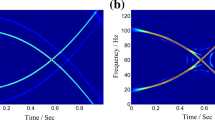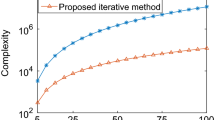Abstract
A method utilizing single channel recordings to blindly separate the multicomponents overlapped in time and frequency domains is proposed in this paper. Based on the time varying AR model, the instantaneous frequency and amplitude of each signal component are estimated respectively, thus the signal component separation is achieved. By using prolate spheroidal sequence as basis functions to expand the time varying parameters of the AR model, the method turns the problem of linear time varying parameters estimation to a linear time invariant parameter estimation problem, then the parameters are estimated by a recursive algorithm. The computation of this method is simple, and no prior knowledge of the signals is needed. Simulation results demonstrate validity and excellent performance of this method.
Similar content being viewed by others
References
Torres W P, Quatieri T F. Estimation of modulation based on FM-to-AM transduction: two-sinusoid case. IEEE Trans Sig Proc, 1999, 47(11): 3084–3097
Peleg S, Friedlander B. Multicomponent signal analysis using polynomial phase transform. IEEE Trans Aerosp Eletr Syst, 1996, 32(1): 378–384
Barbarossa S, Petrone V. Analysis of polynomial-phase signals by the integrated generalized ambiguity function. IEEE Trans Sig Proc, 1997, 45(2): 316–327
Boashash B, Ristic B. Polynomial time-frequency distributions and time-varying higher order spectra: Application to the analysis of multicomponent FM signals and to the treatment of multiplicative noise. Sig Proc, 1998, 67(1): 1–23
Hussain Z M, Boashash B. Adaptive instantaneous frequency estimation of multicomponent FM signals using quadratic time-frequency distributions. IEEE Trans Sig Proc, 2002, 50(8): 1866–1876
Alieva T, Bastiaans M J, Stankovic L J. Signal reconstruction from two close fractional fourier power spectra. IEEE Trans Sig Proc, 2003, 51(1): 112–123
Jang G-J, Te-Won L, Yung-Hwan O. Single-channel signal separation using time-domain basis functions. IEEE Sig Proc Lett, 2003, 10(6): 168–171
Panbong H, Ann S. Robust time-varying parametric modeling of voiced speech. Sig Proc, 1995, 42(3): 311–317
David S. Prolate spheroidal wave functions, fourier analysis, and uncertainty—the discrete case. Bell Syst Tech J, 1978, 57(5): 1371–1430
Gueguen C. An introduction to displacement ranks. Sig Proc, 1987, 23(12): 705–780
Balasubramaniam S, Maragos P. Multicomponent AM-FM demodulation via periodicity based algebraic separation and energy-based demodulation. IEEE Trans Commun, 2000, 48(3): 473–490
Friedlander B, Francos J M. Estimation of amplitude and phase parameters of multicomponent signals. IEEE Trans Sig Proc, 1995, 43(4): 917–926
Author information
Authors and Affiliations
Corresponding author
Additional information
Supported by the Program for New Century Excellent Talents in University, Ministry of Education, China (Grant No. NCET-05-0803)
Rights and permissions
About this article
Cite this article
Cai, Q., Wei, P. & Xiao, X. A blind separation method of overlapped multi-components based on time varying AR model. Sci. China Ser. F-Inf. Sci. 51, 81–92 (2008). https://doi.org/10.1007/s11432-008-0001-9
Received:
Accepted:
Issue Date:
DOI: https://doi.org/10.1007/s11432-008-0001-9




